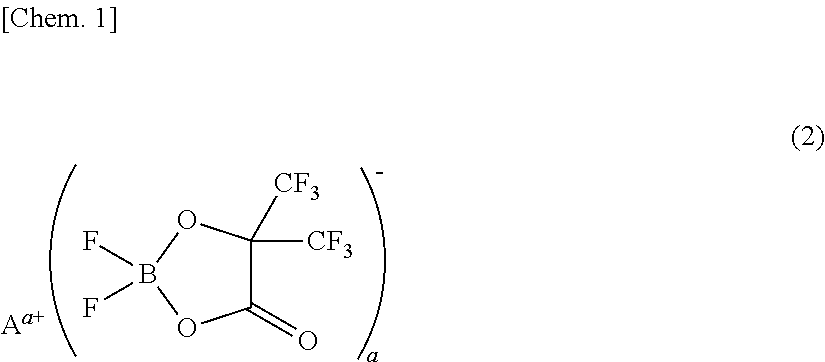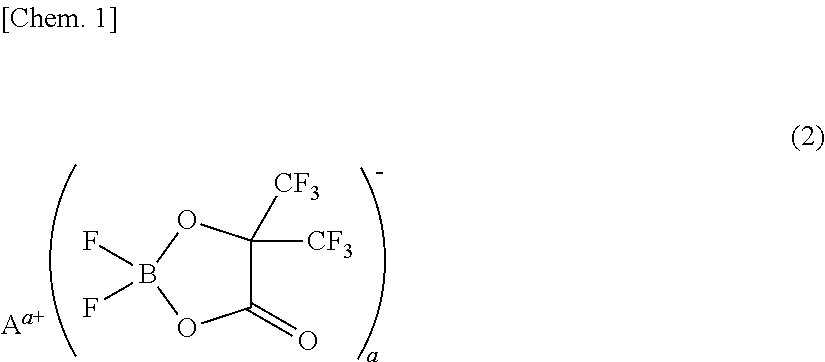Non-aqueous electrolyte additive, non-aqueous electrolyte, and non-aqueous electrolyte secondary battery
a technology of non-aqueous electrolyte and additive, which is applied in the direction of primary cells, non-aqueous electrolyte cells, electrochemical generators, etc., can solve the problems of high activity of alkali metals used as negative electrode materials for non-aqueous electrolyte secondary batteries, inability to exhibit sufficient safety, and high activity of alkali metals (especially lithium metals, lithium alloys, etc., to achieve the effect of improving the safety and battery characteristics
- Summary
- Abstract
- Description
- Claims
- Application Information
AI Technical Summary
Benefits of technology
Problems solved by technology
Method used
Image
Examples
example 1
Preparation of Non-Aqueous Electrolyte
[0073]A non-aqueous electrolyte was prepared by adding 1 mL (1% by volume) of a phosphazene compound of the first compound group (a cyclic phosphazene compound represented by the above general formula (1) in which n is 3, five Rs are fluorine, and one R is a hexafluoroisopropoxy group; flash point: none) (non-aqueous electrolyte additive) to 99 mL of a mixed solvent of ethylene carbonate, dimethyl carbonate, and ethyl methyl carbonate (mixture ratio (volume ratio) of ethylene carbonate / dimethyl carbonate / ethyl methyl carbonate=1 / 1 / 1) (aprotic organic solvent), further dissolving difluoro(trifluoro-2-oxide-2-trifluoro-methylpropionato(2-)-O,O)lithium borate (LiBF2(HHIB), a borate with Aa+ being Li+ in the above general formula (2)) (non-aqueous electrolyte additive) from the second compound group therein at a concentration of 5% by mass, and then dissolving LiPF6 (supporting salt) therein at a concentration of 0.95 mol / L. The safety and resistanc...
example 2
[0086]A non-aqueous electrolyte was prepared in the same way as in the “Preparation of Non-Aqueous Electrolyte” of Example 1, except that the mixed solvent of ethylene carbonate, dimethyl carbonate, and ethyl methyl carbonate was 97 mL, the phosphazene compound was 3 mL (3% by volume), and the second compound group was replaced with difluoro(oxalato)borate sodium at a concentration of 0.1% by mass. The safety and resistance to deterioration were then evaluated. Non-aqueous electrolyte secondary batteries were produced in the same way as Example 1, and the charge-discharge cycle performance and low-temperature characteristics were measured and evaluated. Table 1 lists the results.
example 3
[0087]A non-aqueous electrolyte was prepared in the same way as in the “Preparation of Non-Aqueous Electrolyte” of Example 1, except that the mixed solvent of ethylene carbonate, dimethyl carbonate, and ethyl methyl carbonate was 95 mL, the phosphazene compound was 5 mL (5% by volume), and the second compound group was replaced with difluoro(bisoxalato)phosphate lithium at a concentration of 1% by mass. The safety and resistance to deterioration were then evaluated. Non-aqueous electrolyte secondary batteries were produced in the same way as Example 1, and the charge-discharge cycle performance and low-temperature characteristics were measured and evaluated. Table 1 lists the results.
PUM
 Login to View More
Login to View More Abstract
Description
Claims
Application Information
 Login to View More
Login to View More - R&D
- Intellectual Property
- Life Sciences
- Materials
- Tech Scout
- Unparalleled Data Quality
- Higher Quality Content
- 60% Fewer Hallucinations
Browse by: Latest US Patents, China's latest patents, Technical Efficacy Thesaurus, Application Domain, Technology Topic, Popular Technical Reports.
© 2025 PatSnap. All rights reserved.Legal|Privacy policy|Modern Slavery Act Transparency Statement|Sitemap|About US| Contact US: help@patsnap.com



